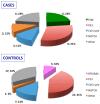Mutational Profiles of Cutaneous Squamous Cell Carcinomas with Different Patterns of Clinical Aggression from Head and Neck Regions
- PMID: 38893077
- PMCID: PMC11171166
- DOI: 10.3390/cancers16111956
Mutational Profiles of Cutaneous Squamous Cell Carcinomas with Different Patterns of Clinical Aggression from Head and Neck Regions
Abstract
Cutaneous squamous cell carcinoma is a prevalent malignancy with a rising incidence and a notably high mutational load. Exploring the genetic nuances of cSCC and investigating molecular approaches stands as a potential avenue for improving outcomes in high-risk patients. This retrospective case-control study involved two cohorts, one of 14 patients (the "discovery cohort") and the other of 12 patients (the "validation cohort"), with cSCC located in the head/neck anatomical region and diagnosed at the pT2 stage. Overall, cases developed early local relapses of the disease, whereas controls never relapsed during the entire follow-up period. A next-generation sequencing (NGS) approach conducted on histological samples revealed that TP53 and CDKN2A were the most frequently mutated genes in our series. No specific mutations were identified as potential prognostic or therapeutic targets. Controls exhibited a tendency toward a higher mutational rate compared to cases. It is possible that an increased number of mutations could prompt the cSCC to expose more antigens, becoming more immunogenic and facilitating recognition by the immune system. This could enhance and sustain the immunological response, potentially preventing future recurrences.
Keywords: cutaneous squamous cell carcinoma (cSCC); immunogenicity; mutation profile; next-generation sequencing (NGS); non-melanoma skin cancer; recurrent cSCC.
Conflict of interest statement
The authors declare no conflicts of interest. The funders had no role in the design of the study; in the collection, analyses, or interpretation of data; in the writing of the manuscript; or in the decision to publish the results.
Figures



References
-
- Muzic J.G., Schmitt A.R., Wright A.C., Alniemi D.T., Zubair A.S., Olazagasti Lourido J.M., Sosa Seda I.M., Weaver A.L., Baum C.L. Incidence and Trends of Basal Cell Carcinoma and Cutaneous Squamous Cell Carcinoma: A Population-Based Study in Olmsted County, Minnesota, 2000 to 2010. Mayo Clin. Proc. 2017;92:890–898. doi: 10.1016/j.mayocp.2017.02.015. - DOI - PMC - PubMed
-
- Rubió-Casadevall J., Hernandez-Pujol A.M., Ferreira-Santos M.C., Morey-Esteve G., Vilardell L., Osca-Gelis G., Vilar-Coromina N., Marcos-Gragera R. Trends in incidence and survival analysis in non-melanoma skin cancer from 1994 to 2012 in Girona, Spain: A population-based study. Cancer Epidemiol. 2016;45:6–10. doi: 10.1016/j.canep.2016.09.001. - DOI - PubMed
Grants and funding
LinkOut - more resources
Full Text Sources
Research Materials
Miscellaneous

